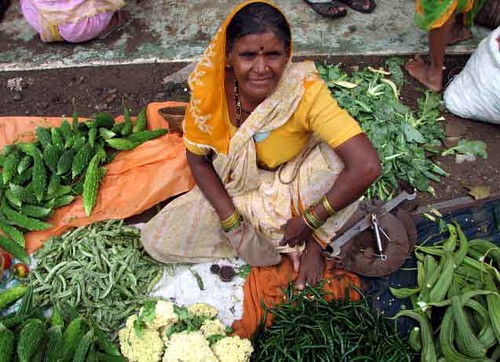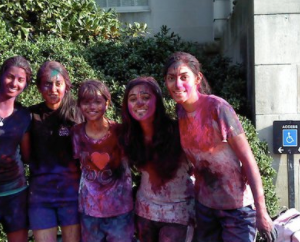Photo Story
Indian Bazaars: A Snapshot of Local Culture
ID # 1244
Being in an Indian bazaar or street market gives one a glimpse of what is important to that community in India. Every bazaar is different: the goods sold in one bazaar cater to the needs of a particular community at a particular time. As the needs of the community change, the goods sold change in response to the change in demand. The diversity and evolution of bazaars mirrors the diversity and evolution of India as a country. This picture file will give some examples of the diverse goods sold in these street markets. It will also help students understand how bazaars are a microcosm of the local community, as they mirror its customs, traditions, social norms etc. through the goods sold and the way they are sold. Overall, Indian bazaars allow one to experience the local culture both by interacting with people and understanding important items of the local culture. Bazaars are indicative of India’s diversity, as each one is different according to region and time period.
Objective: Students will be able to name some goods commonly found in Indian bazaars.
From: Travel Photos for You
1. Among the most popular items sold in bazaars are clothing and jewelry. In this picture are saris are being sold in a bazaar in Hyderabad, India. Saris are the traditional garment worn by women in India. The sari, as well as other clothing has evolved over time and many clothing vendors display garments that are considered the most fashionable. These fashions change over time, and by region and bazaar vendors change their goods accordingly.
Have you ever heard of a sari? Have you ever seen someone wearing one? What did you think?
2. Items like spices, grains, vegetables and fruit are all sold in a bazaar. These items tend to be from local areas, unlike large franchise markets. Also common are chaat vendors that sell Indian snacks. Chaat, which is an umbrella term used to describe food commonly sold at these road-side stands, is made with a variety of spices.
In this picture is a chaat vendor in Hyderabad that is selling chole. By looking at the food sold in bazaars one can get a glimpse of local cuisine and ingredients commonly used. The food sold in each region varies greatly depending on the items available. Every item sold at these stands is incredibly tasty and unique.
Have you ever had chaat or other Indian food? How does it compare to food you eat locally?
From Mumbai Paused Blog
3.Movies, music, and art, and literature are all a huge part of Indian culture. One can find the Bollywood movies, the latest film in the regional language, soundtracks, art, books and much more in a bazaar. It is a hub for selling both goods of the latest entertainment fads and harder to find classics. These items are also commonly written or dubbed in the local language. Through the forms of arts and entertainment sold in a bazaar, one can experience both the past and present culture of the region. Here is a stand selling books and magazines written in Hindi.
Have you ever heard of Bollywood movies? How do you think they compare to movies you usually watch?
4.Apart from getting DVDs and books made in the regional language, a bazaar gives immense exposure to the regional language in other ways. Many of the signs are written in the regional language. This can be seen in this picture, where the signs are written in Telugu, which is a language spoken in Andhra Pradesh. Also, exposure to the spoken language of the region is also a great benefit of going to a bazaar, where bargaining is considered the norm. It is a common occurrence to see people yell at each other in the regional language as they haggle.
Do you hear people speaking a different language in the market you go to? What languages have you heard?

5.Items sold in a bazaar can also be indicative of religions most commonly practiced. In regions of India like Andhra Pradesh, where there are many Hindus practicing, once can find many statuettes of Indian idols. In this statues of the Hindu god Ganesh are being sold. In other regions where Islam or Christianity is quite prevalent, one can also find prayer pendants, or crosses.

From Flickr User
Bazaars not only give exposure to the local culture and diversity, but also exposure to events occurring in the community. For example during times of increased unemployment, one can see more beggars or vendors selling off sheets to make money, as one can see in this picture. During times of festivity, there is an increase in the number of sweet vendors, and vendors selling firecrackers.
How does your local community change during times of festivity?
With the increase of globalization, many bazaars across India are drastically different than they were just several decades ago. Rather than just selling goods that are popular in the region, there is a rise in the number of goods from other countries. One can now find some goods from China and even America. For example, in this picture most of the signs are written in English. Many of the people can be seen wearing Western clothes. Even the vendors themselves are more globalized. Vendors that could once only speak the regional language, and perhaps Hindi, can speak some English as well.
How do your local markets compare to Indian bazaars? Do you see any similarities between an Indian bazaar and places like flea markets and farmers markets?
Remainder of images from a friend.
Created By
Alekhya Yechoor
Hi! I am Alekhya Yechoor and I am a Biology major at the University of North Carolina at Chapel Hill.





